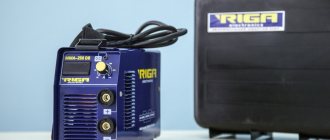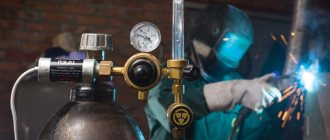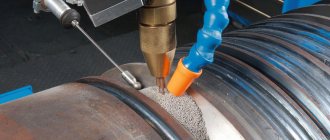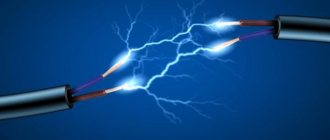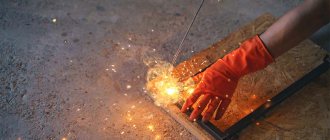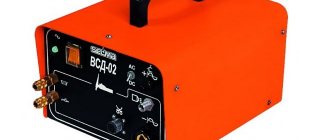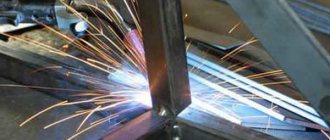Static current-voltage characteristic.
The static current-voltage characteristic is the dependence of the arc voltage on the supplied welding current at a constant arc length.
This characteristic directly depends on the power source. There are three types of static characteristics: Welding performed under normal conditions or using argon is characterized by the first type of current-voltage characteristic. In this case, the welding current used has low current values (up to 80 Amperes), allowing for small-sized welds.
With an increase in the current used during welding under normal conditions, the ionization process is activated and at the same time the area of the resulting arc cross-section increases, which greatly facilitates the welding process. During a welding arc in an argon environment, intense ionization of the gas environment itself occurs with a significant increase in the temperature of the shielding gas.
The welding arc, which occurs at a current strength of 80 to 300 Amperes, is characterized by the second type, which is characterized by the addition of low voltage values. In this case, the resulting cross-sectional area will be proportional to the current used during welding, which makes it possible to obtain seams of the required size and connect various structures made of various materials. The conductivity of the welding arc remains constant.
When welding with a current exceeding 300 Amperes, they speak of an increasing current-voltage characteristic. In this case, the resulting voltage increases as a result of the accumulation of a large number of charged particles on the electrode, automatically causing a voltage drop at the cathode.
Thus, we can say that a falling static current-voltage characteristic is characterized by an increase in current strength with a decrease in voltage. Rigid type is characterized by independence of voltage from current. For increasing - the voltage increases with increasing welding electric current.
In the process of manual welding with an electrode with an alloy coating, the characteristic will decrease; as the current increases, it will become hard. When welding using flux or in a carbon dioxide environment, a rigid static characteristic will turn into an increasing one. With a constant current, the voltage can only change depending on the length of the arc.
Combustion conditions
The essence of the welding process is the conversion of electrical energy into thermal energy.
To maintain the welding column, it is necessary to create conditions for rapid ionization of the gas: the parts are heated so that the air around them is warm, or a gas capable of ionization is supplied to the working area. Particles of alkali and alkaline earth metals are most easily ionized. When current is passed through the rod, their particles become active.
To prevent the arc column from extinguishing, it is important to maintain a constant temperature in the cathode region. It directly depends on the chemical composition of the cathode and its area. The required temperature is maintained by a current source; in industrial conditions it reaches 7 thousand degrees.
2.1.2. Current-voltage characteristic of the arc (volt-ampere)
The most important characteristic of the arc is the dependence of the voltage on it on the current value. This characteristic is called current-voltage. There is a static current-voltage characteristic and a dynamic current-voltage characteristic.
the arc temperature increases, thermal ionization increases, the number of ionized particles in the discharge increases and the electrical resistance of the arc decreases .
The arc voltage is equal to
.
The dependence of the voltage on the arc on the current when it changes slowly is called the static current-voltage characteristic of the arc.
The static characteristics of the arc depend on the distance between the electrodes (arc length), the material of the electrodes and the parameters of the environment in which the arc burns.
a) Static current-voltage characteristic
, —
arc voltage;
—
sum of near-electrode voltage drops;
—
field strength in the arc column;
depends on the current and the conditions under which the arc burns. The static current-voltage characteristics of the arc are as follows:
The longer the arc length, the higher its static current-voltage characteristic lies. As the pressure of the medium in which the arc burns increases, the intensity E
and the current-voltage characteristic rises. Arc cooling significantly affects this characteristic. The more intense the cooling of the arc, the more power is removed from it. In this case, the power released by the arc should increase. For a given current, this is possible by increasing the arc voltage. Thus, with increasing cooling, the current-voltage characteristic rises. This is widely used in arc extinguishing devices of apparatus.
The arc current-voltage characteristic (Fig. 1) is shown for low current densities (up to 100 A/mm 2 ). With a further increase in current, the current-voltage characteristic becomes horizontal. If you continue to increase the current, the voltage will begin to increase.
Elasticity of the welded arc.
When welding, it is necessary to take into account the length of the arc used in welding, since such an important characteristic as elasticity directly depends on it.
To obtain a high-quality weld, uninterrupted combustion of the welding arc is necessary, which is characterized by the elasticity of the welding arc. An arc is said to be sufficiently elastic if the welding process remains stable as the length of the welded arc increases.
The resulting elasticity is directly proportional to the current value. With high changing parameters of the power source, the transition period is shortened during various changes in the electrical system, which allows you to obtain a high-quality connection in a short period of time.
What affects the power of the electric arc
The power indicators of the welding electric arc depend on the following main factors:
- supply voltage. An increase in supply voltage leads to an increase in arc power. However, the range of changes in the values of the last parameter is not wide. There are also restrictions regarding the size of the electrodes;
- current strength. The dependence is directly proportional. As this parameter increases, the stability of the electric arc increases;
- The dependence of the power and the numerical value of the voltage of the resulting plasma is also directly proportional.
The arc length is the distance from the consumable element to the surface to be welded during the work. This indicator affects the amount of heat generated.
The rate of metal melting is determined by the power of the electric arc. This parameter is very important. After all, it depends on how long it takes to connect the metal parts. The temperature in the melting region is changed by the current strength. If it is large enough, the electric arc will not go out even of considerable length. It is very rare to adjust the amperage during welding.
Current-voltage characteristics of the arc
At the initial moment, a slightly higher voltage is required to initiate the arc than during its subsequent combustion. This is explained by the fact that when an arc is excited, the air gap is not heated enough, the degree of ionization is low, and a voltage is needed that can impart such energy to free electrons that ionization can occur when they collide with atoms of the gas gap. An increase in the concentration of free electrons in the arc volume leads to intense ionization of the arc gap, and hence to an increase in its electrical conductivity. As a result, the voltage drops to the value required for stable arcing.
The dependence of the arc voltage on the current and the welding circuit is called the static current-voltage characteristic of the arc.
The current-voltage characteristic of the arc (Fig. 8, a) has three regions: decreasing 1, hard 2 and increasing 3. In region 1 (up to 100 A), with increasing current, the voltage decreases significantly. This occurs due to the fact that as the current increases, the cross-section and, consequently, the conductivity of the arc column increases. In region 2 (100.1000 A), as the current increases, the voltage remains constant, since the cross-section of the arc column and the area of the anode and cathode spots increase in proportion to the current. The region is characterized by a constant current density. In region 3, the voltage increases due to the fact that an increase in current density above a certain value is not accompanied by an increase in the cathode spot due to the limited cross-section of the electrode. The arc of region 1 burns unstable and is therefore of limited use. The arc of area 2 burns steadily and ensures a normal welding process.
The current-voltage characteristic of the arc during manual arc welding of low-carbon steel (Fig. 8, b) is presented in the form of curves a (arc length 2 mm) and b (arc length 4 mm). Curves c (arc length 2 mm) and d (arc length 4 mm) refer to automatic submerged arc welding at high current densities.
The voltage required to initiate an arc depends on the type of current (direct or alternating), the length of the arc gap, the material of the electrode and the edges being welded, the coating of the electrodes and a number of other factors. The voltage values that ensure the occurrence of an arc in arc gaps equal to 2.4 mm are in the range of 40.70 V.
Nature and structure
In a short time, the metal can be heated to its melting temperature using a powerful welding arc. Its properties are characterized by current density and current-voltage indicators. From the point of view of electrical engineering, an arc column is an ionized gas conductor between the cathode and anode with high resistance and the ability to glow. A detailed examination of the structure of the welding arc will help to understand the essence of temperature effects. The average length of the electric arc is 5 mm, it is divided into main zones:
- anodic, it is no more than 10 microns;
- cathode, it is 10 times smaller than the anode;
- pillar - a visible luminous strip.
The temperature of the welding arc is determined by the flow of free electrons. They are formed at the cathode spot. It heats up to 38% of the plasma temperature. In an arc column, electrons move towards the anode and positive particles move towards the cathode. The column has no charge of its own; it remains neutral. Inside, the particles are heated to 10,000°C, while the metal is heated on average to 2350°C, the standard temperature of the melt bath is 1700°C.
The place where electrons enter and are neutralized is called the anode spot. Its temperature is 4–6% higher than that of the cathode.
The voltage in the anode and cathode zones is significantly reduced, and no glow occurs. Only plasma that emits ultraviolet, infrared and light waves is visible. They are harmful to the organs of vision and skin. Therefore, welders use personal protective equipment.
Welding arc structure
Efficiency.
Welding is always accompanied by the release of a large amount of heat, which is used to melt the parts being welded. Almost all consumed electrical energy is transformed into thermal energy, with the help of which the metal melts and the surrounding air is heated.
The efficiency in any welding operation has different values and largely depends on the brand of electrodes, the chemical composition of the flux, the type of welded joint and the speed of welding.
To obtain high-quality welds, when organizing the welding process, it is imperative to take into account all the characteristics of the welding arc and control them during operation. This will optimize the entire process and minimize side energy costs. Compliance with all parameters of the welding arc for the selected type of welding is a necessary condition for ensuring high quality work. In addition, this will ensure a long service life of the connected structures.
Things to know
The ultraviolet component of arc radiation is extremely dangerous to the eyes and skin, so welders use a protective suit and mask with tinted glass. Glare reflected from walls can also cause retinal burns, accompanied by severe pain.
The arc voltage in manual welding is low.
The arc voltage during manual welding is small - from 15 to 30 V. But during the process of replacing consumables, it increases to 70 V and can cause an electric shock. Special care is required from the welder.
When working with a machine, the risk of electrical injury is significantly lower.
Classification of welding arc power sources
By type of welding current
So, we have already figured out that the power source can be a transformer, rectifier and generator. But in a broader sense, all these sources can be divided into several subgroups. One of them is the type of current that the source generates.
The source can generate direct or alternating current. A classic transformer and high-frequency generator often generates alternating current. The welding rectifier generates direct current.
What is the difference between a DC and an AC power source?
What is the difference between AC and DC welding machines? Let's figure it out.
The AC machine is very simple: it is assembled from a step-down transformer and a special mechanism that regulates the strength of the welding current. When using an alternating current welding arc, welding is carried out using alternating current, respectively.
The DC device is more technologically advanced. Its main components are a step-down transformer, a current rectifying device (rectifier) that converts the incoming alternating current to direct current, and a current control device. Accordingly, here welding is carried out using direct current.
These are the main design differences. There are also operational differences. DC welding is preferred because this current source has more advantages. DC devices are much more compact and easier to use, they are more technologically advanced, and are generally considered more modern. Welding with alternating current is more difficult and is characterized by instability of the arc.
We also mention inverter power supplies, which are currently considered the most technologically advanced and widespread. These are complex devices that repeatedly transform the current, smoothing it using special filters, and subsequently rectify it. As a result, the welder receives direct current, which means an extremely stable arc that is easily ignited. Inverter devices are also equipped with an electronic control unit, which is easy to use.
An inverter welding power source is the most common type at the moment. Such devices are the most compact and light (there are models on sale weighing no more than 3-5 kg), and they are equipped with additional functionality that simplifies welding.
By number of posts and installation method
Everything is much simpler here. Regardless of the type of power source, be it variable or constant, transformer or inverter, any of them can have either one welding connector or 3 or more.
Devices with one connector are called single-station and are designed to generate one welding arc. That is, for use by one welder. Devices with a large number of connectors are called multi-station, and several welders can weld from one machine at once.
Depending on the installation method, power supplies can be mobile (portable) or stationary.
Source
Welding arc definition
This phenomenon is a stable, not limited in time, electric discharge in an environment formed by air or protective gases and metal vapors. It has conductivity only in the ionized state, in other words, when it contains particles with a positive or negative sign. The gas existing under such conditions is called plasma. Negative charge carriers are electrons, positive charge carriers are atoms or molecules deprived of them.
Thus, the definition of a welding arc may sound like this: it is a long-lasting electrical discharge in a plasma consisting of air or shielding gases and metal vapors.
The main property of this phenomenon is the release of a large amount of heat, which is always observed when current flows. It causes the metal to melt.
Elasticity of the welded arc.
When welding, it is necessary to take into account the length of the arc used in welding, since such an important characteristic as elasticity directly depends on it.
To obtain a high-quality weld, uninterrupted combustion of the welding arc is necessary, which is characterized by the elasticity of the welding arc. An arc is said to be sufficiently elastic if the welding process remains stable as the length of the welded arc increases.
The resulting elasticity is directly proportional to the current value. With high changing parameters of the power source, the transition period is shortened during various changes in the electrical system, which allows you to obtain a high-quality connection in a short period of time.
Difference between reverse and direct polarity
Direct polarity is the connection of the “plus” of the device to the product, and the negative terminal of the device to the electrode (consumable or non-consumable). “+” is the anode, and “-” is the cathode.
As we said earlier, the anode zone heats up more strongly - up to a temperature of 4200 degrees Celsius. It is straight polarity that is used when welding with a non-consumable electrode to reduce heat in the electrode and extend its service life.
The use of reverse polarity when welding with a consumable electrode provides a higher heat input into the electrode. Which ensures its more active melting. The heat input into the product is also reduced, which reduces its deformation.
Efficiency.
Welding is always accompanied by the release of a large amount of heat, which is used to melt the parts being welded. Almost all consumed electrical energy is transformed into thermal energy, with the help of which the metal melts and the surrounding air is heated.
The efficiency in any welding operation has different values and largely depends on the brand of electrodes, the chemical composition of the flux, the type of welded joint and the speed of welding.
To obtain high-quality welds, when organizing the welding process, it is imperative to take into account all the characteristics of the welding arc and control them during operation. This will optimize the entire process and minimize side energy costs. Compliance with all parameters of the welding arc for the selected type of welding is a necessary condition for ensuring high quality work. In addition, this will ensure a long service life of the connected structures.
How to adjust arc length
Not only electrical quantities, but also the quality of welding depend on this parameter. They strive to make the arc as short as possible, within 3-4 mm.
With a longer length, the following negative phenomena are observed:
- Drops of molten metal from the electrode on the way to the weld pool manage to absorb a lot of oxygen and nitrogen from the air. As a result, the seam loses strength, ductility and toughness.
- The discharge moves along the surface of the workpiece (wandering), as a result of which the heat is distributed over a relatively large area. The penetration depth decreases; drops of melt from the consumable, falling on unheated metal, do not merge with it, but bounce off.
We recommend reading How ultrasonic flaw detection is used
A short arc produces a dry crackling sound, reminiscent of oil sizzling in a hot frying pan.
With a long welding arc, negative phenomena are observed.
The seam she made looks neat and has the following characteristics:
- Correct form.
- Smooth convex surface.
The seam, made with a long arc, has uneven outlines, and drops of molten metal stick along it.
The consumable electrode decreases during the welding process. Therefore, it is gradually brought closer to the workpiece so that the discharge length remains constant.
Classification of welding arc power sources
By type of welding current
So, we have already figured out that the power source can be a transformer, rectifier and generator. But in a broader sense, all these sources can be divided into several subgroups. One of them is the type of current that the source generates.
The source can generate direct or alternating current. A classic transformer and high-frequency generator often generates alternating current. The welding rectifier generates direct current.
What is the difference between a DC and an AC power source?
What is the difference between AC and DC welding machines? Let's figure it out.
The AC machine is very simple: it is assembled from a step-down transformer and a special mechanism that regulates the strength of the welding current. When using an alternating current welding arc, welding is carried out using alternating current, respectively.
The DC device is more technologically advanced. Its main components are a step-down transformer, a current rectifying device (rectifier) that converts the incoming alternating current to direct current, and a current control device. Accordingly, here welding is carried out using direct current.
These are the main design differences. There are also operational differences. DC welding is preferred because this current source has more advantages. DC devices are much more compact and easier to use, they are more technologically advanced, and are generally considered more modern. Welding with alternating current is more difficult and is characterized by instability of the arc.
We also mention inverter power supplies, which are currently considered the most technologically advanced and widespread. These are complex devices that repeatedly transform the current, smoothing it using special filters, and subsequently rectify it. As a result, the welder receives direct current, which means an extremely stable arc that is easily ignited. Inverter devices are also equipped with an electronic control unit, which is easy to use.
An inverter welding power source is the most common type at the moment. Such devices are the most compact and light (there are models on sale weighing no more than 3-5 kg), and they are equipped with additional functionality that simplifies welding.
The nature of the phenomenon
The arc formation process is as follows:
At the moment of contact, a short circuit occurs and the metal at the point of contact melts. Each stage lasts milliseconds, the discharge occurs almost instantly. The current is then maintained by the emission of electrons at the cathode. On their way to the anode, they ionize gas and metal vapor, increasing the number of free charge carriers.
Modern welding machines are equipped with a high-frequency vibration generator (oscillator). This device allows you to excite the arc in a non-contact manner.
Volt-ampere characteristic of the arc (volt-ampere characteristic)
Static current-voltage characteristic of the arc - shows the relationship between the steady-state values of the current and voltage of the arc at a constant arc length. An electric arc, as an element of a current circuit, has a pronounced nonlinearity, that is, there is no proportional relationship between its current I and voltage U. The dependences U = f (I), with other constant conditions, for such elements are most often depicted in the form of curves called current-voltage characteristics (see figure). If the U values are measured in states of stable discharge equilibrium at different currents, then the characteristics are called static. The static characteristics of the arc depend on the distance between the electrodes (arc length), the material of the electrodes and the parameters of the environment in which the arc burns. The construction of current-voltage characteristics is associated with great difficulties, not only due to the difficulty of measuring the arc length between consumable electrodes, but also maintaining constant other conditions.
Discharge duration
In practical applications, continuous discharge mode is more often used. However, pulse mode is also common. It is used for contact welding.
Welding of workpieces is not carried out in a continuous seam, but at several points. Such a connection does not provide tightness, but is strong enough to make thin-walled structures, such as housings for household appliances, various devices and installations, and car bodies.
The process is carried out by a non-consumable massive electrode, which is pressed against the workpiece with great force. A short-term current of very high strength is passed through the electrode - up to several thousand amperes. At the point of contact, the metal of both workpieces melts, and at the end of the pulse it cools and crystallizes as a single whole.
Next, the electrode (or workpiece) moves along the seam line to a new point, is pressed against it and a new impulse is applied.
Roller electrodes for resistance welding
There is a variation of this method that allows you to obtain tight connections. In this case, the electrode is made in the form of a roller rolling along the surface of the workpiece. The pulses are supplied at short intervals; the guiding zones along the rolling line partially overlap and form a continuous weld material. This technology is used for automatic welding of pipelines.
Current-voltage characteristic of the arc (volt-ampere)
The most important characteristic of the arc is the dependence of the voltage on it on the current value. This characteristic is called current-voltage. There is a static current-voltage characteristic and a dynamic current-voltage characteristic.
the arc temperature increases, thermal ionization increases, the number of ionized particles in the discharge increases and the electrical resistance of the arc decreases. The arc voltage is equal. The dependence of the voltage on the arc on the current when it changes slowly is called the static current-voltage characteristic of the arc.
The static characteristics of the arc depend on the distance between the electrodes (arc length), the material of the electrodes and the parameters of the environment in which the arc burns.
a) Static current-voltage characteristic
, — arc voltage; — sum of near-electrode voltage drops; — field strength in the arc column;
depends on the current and the conditions under which the arc burns. The static current-voltage characteristics of the arc are as follows:
The longer the arc length, the higher its static current-voltage characteristic lies. As the pressure of the medium in which the arc burns increases, the intensity E also increases
and the current-voltage characteristic rises. Arc cooling significantly affects this characteristic. The more intense the cooling of the arc, the more power is removed from it. In this case, the power released by the arc should increase. For a given current, this is possible by increasing the arc voltage. Thus, with increasing cooling, the current-voltage characteristic rises. This is widely used in arc extinguishing devices of apparatus.
The arc current-voltage characteristic is given for low current densities (up to 100 A/mm 2 ). With a further increase in current, the current-voltage characteristic becomes horizontal. If you continue to increase the current, the voltage will begin to increase.
Source
